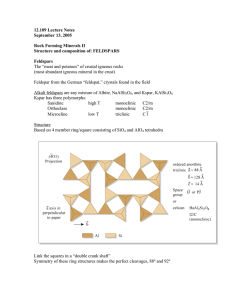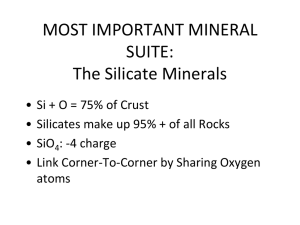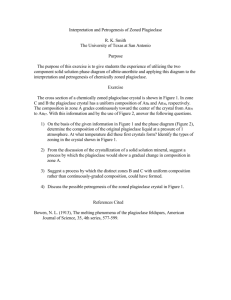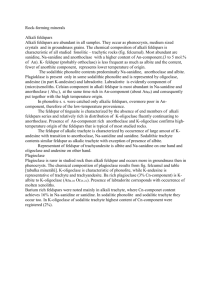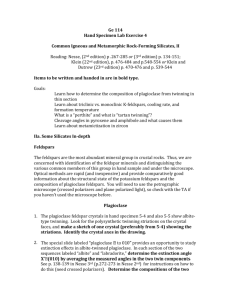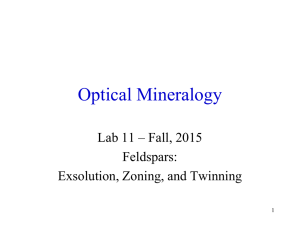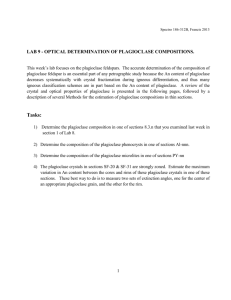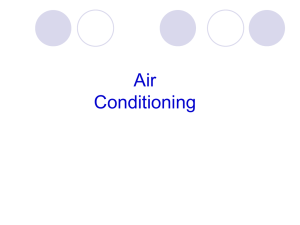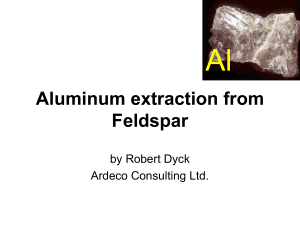feldsparsEND
advertisement
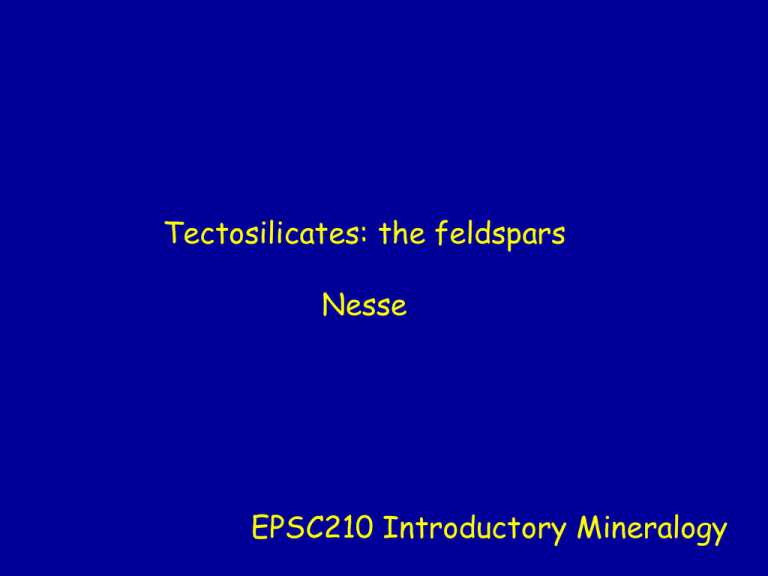
Tectosilicates: the feldspars Nesse EPSC210 Introductory Mineralogy Gem & Mineral Show Montreal Gem & Mineral Club Club de Gemmologie et Minéralogie de Montreal Hippodrome de Montréal / Blue Bonnets (Namur station) (87 dealers, minerals, gemstones, fossils) Friday 4 p.m. to 10 p.m. Saturday 10 a.m. to 7 p.m. Sunday 10 a.m. to 5 p.m. Admission: $4 (students with ID) ; $6 (adults) November,19, 20, 21 2004 Feldspars make up about 50% of the Earth’s crust. Magmatic feldspars undergo important changes during cooling. They are involved in important metamorphic reactions. Their weathering produces much of the clay minerals and aluminum oxi-hydroxides found in sedimentary rocks. Albite (variety cleavelandite is platy) orthoclase KAlSi3O8 ... ... weathers to kaolinite: Al2Si2O5(OH)4 ... which can weather further to bauxite: AlO(OH) When a substitution takes place, in a mineral structure, electrical neutrality must be maintained. In feldspars, this is illustrated by members of the plagioclase series: from Na Al Si3O8 to CaAl2Si2O8 Na + is replaced by Ca 2+ Si 4+ is replaced by Al 3+ When three or more ions are involved in the substitution to preserve electrical neutrality, we call it a coupled substitution. The variety amazonite is an example of colour associated with a vacant site created by the cation substitution: Pb2+ + = 2 K+ in K-felspar Colour center: A vacant site may trap an electron from a nearby ion and it will absorb specific wavelengths, leading to colour. Feldspars have names for very specific ranges of composition. Most cannot be identified in hand specimens. This type of diagram illustrates the chemical changes that take place during the crystallization of liquids of intermediate composition between albite and anorthite. Bowen’s reaction series The earliest feldspar to precipitate from a rapidly cooling igneous rock is usually a Carich plagioclase. It is also the feldspar most susceptible to weathering. This type of diagram illustrates the chemical changes that take place during the crystallization of liquids of intermediate composition between albite and anorthite. Pure anorthite crystallizes at this temperature Pure albite crystallizes at this temperature Liquid of T1 intermediate composition A starts to crystallize at T1, to give a bit of plagioclase, composition B. As liquid T2 cools, the composition of the plagioclase changes. At T2, the plagioclase of composition D. The liquid has lost more Ca than Na, and is now of composition C. The last drop of liquid, composition E crystallizes at T3. If cooling was slow, all the plagioclase is now at T3 composition F. It has the same composition as the original liquid (A). The slow cooling we just described ends up with a plagioclase similar to the original liquid because ions are exchanged back and forth between the growing crystals and the molten liquid. If cooling is fast, ions cannot leave or enter the crystal in time to keep adjusting the plagioclase composition. The result is concentric zoning. (This also happens in rapidly cooled olivines and pyroxenes, by the way... The Mg-rich variety crystallizes at a higher temperature than the Fe-rich variety because Mg-O bond is shorter, stronger). The core of the crystal is more calcium-rich than the edges. Exsolution is a chemical unmixing of the solid crystal during cooling. It occurs by diffusion of ions within the solid (but still hot) crystal, because the mineral structure readjusts and contracts during cooling. It becomes less tolerant of impurities that have the wrong size. Note where complete solid solution occurs (shaded area)... There is a big gap between anorthite and K-feldspar. There is a greater size difference between Ca2+ and K+, and between Al3+ and Si4+, than between Na+ and Ca2+ (their C.N.=9). T1, T2 (tetrahedral) sites become different during cooling because Al3+ and Si4+ start to occupy different tetrahedra within each unit cell as the structure shrinks. The 2/m symmetry decreases to bar 1 In alkali feldspars, the movement of Na and K within the hot mineral gives rise to perthite during cooling. The result of unmixing is often visible to the naked eye. In plagioclases, the movement of Na and Ca is slowed down by the Al-Si exchange (Al-O and Si-O bonds are harder Submicroscopic unmixing gives to break). rise to iridescence. sanidine: the monoclinic K-feldspar which may crystallizes from magma, inverts to orthoclase (and eventually microcline) if cooling is slow. Monoclinic sanidine is only preserved in some lavas or at the rapidly cooled margin of an intrusion. Its Si and Al are evenly distributed among all tetrahedra. This diagram spans a wider temperature range than those in your book (Fig. 5.11, p. 96). NOTE: If there is no loop between the liquid and crystals, the mineral will not develop concentric zoning even at fast cooling rates! High albite and low albite are the Naequivalent of orthoclase and microcline. They show the same tendency for Al and Si to become better ordered among the tetrahedra during cooling, but high and low albite are triclinic. monoclinic triclinic triclinic triclinic As a result, albite (and most plagioclase) grow with polysynthetic twinning even at high temperature because their structure is triclinic. (010) is the pseudo-monoclinic twin law. Microcline grows directly as triclinic from hydrothermal waters (< 300 degrees), and shows twinning by symmetry elements of the monoclinic system. Ease of weathering often correlates with the ionic character of the bonds. In the feldspars, this is not so obvious. In theory, the Ca-rich plagioclase has stronger Ca-O bonds than the Na-O or K-O bonds of alkali feldspars (Ca-O bonds are shorter, charge on Ca+2 is twice that of K+. The weaker link of Ca-rich feldspars may be the Al-O bonds, which are twice as abundant in Cafeldspars as in alkali feldspars. Al-O is longer than Si-O, and Al3+ has a lesser charge than Si4+ . Surprisingly, the most stable feldspar in a weathering environment is K-feldspar (yet K-O bonds are longer than Na-O bonds.)
